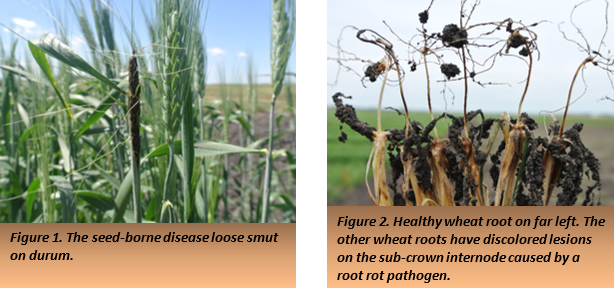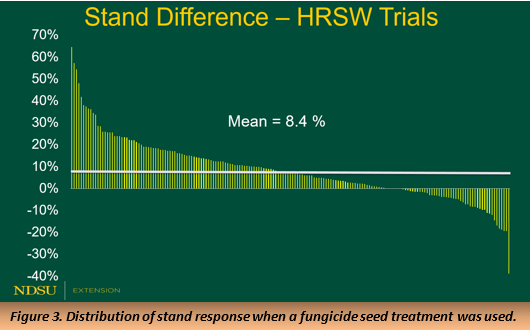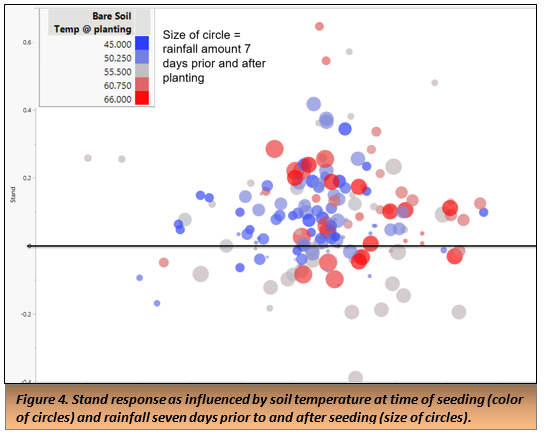Wheat – Fungicide Seed Treatments (04/28/22)
Fungicide seed treatments are labeled in wheat to manage seed-borne diseases, seedling blights, and early-season root rot. They do not have season-long residual and will have little success managing late-season root roots. They are most effective managing seed-borne diseases (Figure 1) and will provide some suppression of early season root rots (Figure 2). With delayed planting likely being a common theme this year, I am anticipating questions regarding if a seed treatment should be used and what type of seed treatment is suggested. The good news is that there are several fungicide seed treatments available for wheat. Most of these appear in the North Dakota Plant Disease Management Guide (PP622) or in the NDSU Extension Pest Management App. You will notice that most labeled seed treatments have more than one mode of action to help manage and suppress diseases that occur as a complex. For example, a field may have multiple root rot pathogens present such as Pythium and Fusarium. Selecting a fungicide seed treatment with multiple modes of action would be helpful, especially one having efficacy on Pythium (such as FRAC 4 or 22) and one having efficacy on Fusarium (such as FRAC 3, 7 or 11). If cool and wet soils persist, we may see more issues with Pythium as the pathogen thrives in cool wet soils, whereas Fusarium can infect in a wide array of temperatures and soil moisture conditions.

Stand Response from a Fungicide Seed Treatment in Wheat
I started compiling and summarizing wheat fungicide seed treatment data several years ago and have continued this effort into 2022. The primary objective is to determine the effect fungicide seed treatments have on wheat stand (% response when compared to naked seed). I have reported results in past issues of the Crop and Pest Report and will report updated data that includes the 2021 growing season. As an added bonus this year, I organized the data to see if stand response was influenced by geography (eastern ND vs. western ND), mode of action (ie: FRAC groups and number of FRAC groups), soil temperature, and rainfall amounts prior to and after seeding.
In the data collected from 2003 to 2021, the average stand response when a fungicide seed treatment was used was 8.4% (Figure 3). This indicates that across 183 replicated treatments, a fungicide seed treatment improved stand by 8.4%. Also, a favorable stand response (greater than zero) was observed 72% of the time.

Table 1. Average stand response for Eastern ND (Fargo) and Western ND (Dickinson/Mott/New Hradec) testing sites.
|
Stand Response Based on Geography |
|
|
Eastern ND (Fargo) |
9.8% |
|
Western ND (Dickinson/Mott/New Hradec) |
7.7% |
|
*Not significantly different from each other |
Table 2. Average stand response for active ingredients with respect to FRAC groups.
|
FRAC group Combinations (with regards to active ingredients) |
|
|
FRAC 3 |
9.1% |
|
FRAC 3,3,4 |
10.7% |
|
FRAC 3,4 |
8.5% |
|
FRAC 3,4,11 |
8.1% |
|
FRAC 3,4,7 |
7.4% |
|
*Not significantly different from each other |
Data was organized into two general testing geographies; Eastern and Western ND. The Eastern ND site included Fargo and Western ND site included data from Dickinson/Mott/New Hradec (Table 1). The analysis revealed that the Fargo site had a stand response of 9.8% and the Dickinson/Mott/New Hradec site had a 7.7% stand response; however these two values were not statistically different from each other. The influence of mode of action and number of mode of actions also was not significant, yet all combinations provided favorable stand responses (Table 2).

To simplify Figure 4, every value above the solid black line indicates a favorable stand response. The color of the circles represent soil temperature (45 to 66 F) at time of seeding and the size of the circle represents the total amount of rainfall received seven days prior to and 7 days after seeding. Figure 4 suggests that there are no consistent trends in stand response with regards to soil temperature and rainfall amounts. Volumetric water content would be a more appropriate measure of soil moisture, however these values were not available for all years. Future studies will look to see if soil moisture influences stand response from a fungicide seed treatment in wheat.
I would like to thank LeAnn Lux, Marcia McMullen, Roger Ashley, and Daryl Ritchison for their help in compiling the data.
Extension Plant Pathology, Cereal Crops
